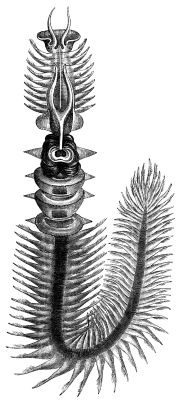Chaetopterus
| Chaetopterus | |
|---|---|
 |
|
| Chaetopterus sp. | |
| Scientific classification | |
| Kingdom: | Animalia |
| Phylum: | Annelida |
| Class: | Polychaeta |
| Order: | Canalipalpata |
| Family: | Chaetopteridae |
| Genus: |
Chaetopterus Cuvier, 1827 |
Chaetopterus or the parchment worm or parchment tube worm is a genus of marine polychaete worm that lives in a tube it constructs in sediments or attaches to a rocky or coral reef substrate. The common name arises from the parchment-like appearance of the tubes that house these worms. Parchment tube worms are filter feeders and spend their adult lives in their tubes, unless the tube is damaged or destroyed. They are planktonic in their juvenile forms, as is typical for polychaete annelids. Species include the recently discovered deep water Chaetopterus pugaporcinus and the well-studied Chaetopterus variopedatus.
The tubes the worms live in are either attached to rocks, or, more commonly, buried in sandy bottoms in shallow waters. The worm has spines along its body segments that are modified for tunneling into the sandy substrate to create the u-shaped tube within which it lives. The tubes are upright u-shaped tunnels lined with mucous, then the parchment tube, with the worm living inside the parchment tube. Each parchment tube ends with a chimney of parchment that juts above the subtrate. The tubes can be as long as 85 centimeters and up to 4 centimeters in diameter at the widest portion in the buried central part of the tube. The chimneys may be wide or much narrower than the rest of the tube.
The worms are unique among the polychaete worms in the highly derived parapodia of the mid-segments of its body that are used in its specialized filter feeding regime. The worm's parapodia are modified into the shape of fans and used to create suction and pump water through the worm's parchment living tube. The morphology of the structures are used in identifying species. The worm feeds by using modified structures on its midbody segments that create mucus nets to trap food passed through the net. A flow of water containing plankton and organic debris is created by "circular flaps" on three segments that create suction that draws water through the living tube.
Members of the genus have no organs for detecting light and live their entire adult lives in their buried tubes. In spite of this, known members of the genera exhibit strong bioluminescence. When the worm is disturbed in its home it moves to the end of the tube away from the disturbance and near the disturbance it emits its feeding mucus with crystals that exhibit blue luminescence.
...
Wikipedia
